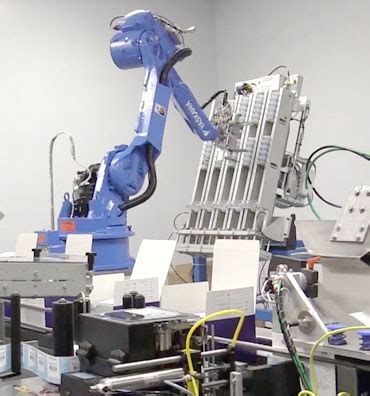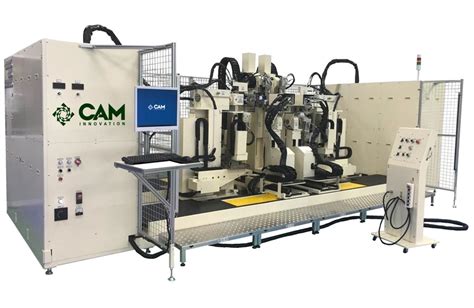custom automated machine,CAM Innovation, Inc. ,custom automated machine,CAM offers a comprehensive range of machines for producing AC and DC form coils, catering to both OEMs and aftermarket customers. Our solutions include coil formers, hot presses, coil presses, wire preparation equipment, and more. . The Chanel No 5 cream provides a fragrance that lasts through out the day. The delightful texture is soft and creamy. It makes a perfect addition to your .

In the ever-evolving landscape of manufacturing, businesses face the constant challenge of improving efficiency, reducing costs, and maintaining quality standards. One of the most effective ways to address these challenges is through the use of custom automated machines. These machines offer tailor-made solutions that can streamline production, increase precision, and enhance overall performance. This article delves into the realm of custom automated machines, exploring the various components and benefits of this cutting-edge technology, as well as the role of specialized companies in providing these solutions.

What Are Custom Automated Machines?
Custom automated machines refer to machines designed and built to perform specific tasks within a production process. Unlike off-the-shelf automation equipment, custom machines are tailored to meet the unique needs and specifications of a particular manufacturer. These machines often involve a combination of robotics, sensors, actuators, and software systems to perform complex tasks with precision and speed.
In the context of modern manufacturing, custom automation solutions are a vital tool for improving productivity, reducing human error, and maintaining consistent quality. They are used across a wide range of industries, including automotive, pharmaceuticals, electronics, food and beverage, and consumer goods, among others.
The Process of Designing Custom Automated Machines
The creation of custom automated machines is not a simple task. It involves a collaborative effort between a manufacturing company and automation specialists. Here’s a step-by-step overview of the process involved in designing and implementing a custom automated machine.
1. Consultation and Requirements Analysis
The first step in creating a custom automated machine is understanding the specific needs of the client. This begins with a thorough consultation where the production processes, challenges, and desired outcomes are discussed. Engineers work closely with clients to assess the existing workflow and identify areas where automation could bring improvements. The goal is to understand both the technical requirements and the business objectives, such as reducing production time, increasing throughput, or improving product quality.
2. Conceptual Rendering and Design
Once the requirements are clear, the design phase begins. This involves the creation of conceptual renderings and 3D models of the proposed machine. Using advanced computer-aided design (CAD) software, engineers create a detailed visualization of how the machine will function within the production environment. This stage also includes selecting the materials, components, and technologies that will be used to build the machine.
The benefit of using CAD software is that it allows engineers to test and refine the design virtually, making it easier to spot potential issues before moving forward with manufacturing.custom automated machine
3. Engineering and Prototyping
Once the conceptual design is approved, the engineering phase begins. During this phase, detailed technical specifications are created for the machine, including the mechanical, electrical, and software systems that will be used. The machine's control systems, such as Programmable Logic Controllers (PLCs) and Human-Machine Interfaces (HMIs), are designed and integrated to ensure seamless operation.
Prototyping is a critical step in the process. A prototype machine is built and tested in a controlled environment to identify potential issues and make necessary adjustments before full-scale production. Prototyping allows for validation of the design and ensures that the machine will meet the desired performance standards.
4. Documentation and Manufacturing Specifications
Once the design is finalized, detailed documentation is prepared. This includes all the technical drawings, electrical schematics, parts lists, and assembly instructions. These documents serve as a blueprint for the manufacturing process and ensure that the machine is built to the highest standards of quality and safety.
Manufacturing specifications include the exact materials, tolerances, and procedures that will be followed during the construction of the custom automated machine. These documents are critical for ensuring that the final product matches the agreed-upon design.
5. Manufacturing and Assembly
With all specifications in hand, the machine enters the manufacturing phase. Components are sourced, and the machine is assembled in a factory setting. Depending on the complexity of the machine, this phase may involve a combination of manual labor and automated processes to assemble the machine.
Once the machine is assembled, rigorous testing is conducted to ensure that it functions according to the specifications. This includes both performance testing and safety checks to ensure that the machine can operate reliably and safely in the client’s production environment.
6. Installation and Commissioning
After the machine has been built and tested, it is delivered to the client’s facility for installation. A team of engineers works to integrate the machine into the existing production line and ensure that it operates seamlessly with other equipment. Once installed, the machine undergoes final commissioning, which involves fine-tuning the system and training the operators.

custom automated machine Chanel in Charlotte, NC is a boutique offering a curated selection of high-end fashion and .
custom automated machine - CAM Innovation, Inc.





















































